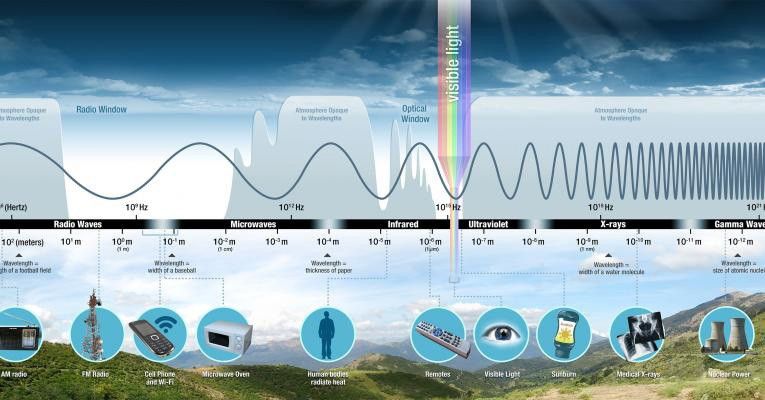Introductory Guiding Question
Where do you find invisible light?
Big Idea 2.3
Educator Background
-
Human eyes can see visible light and the objects that are illuminated by this light. Visible light is only a very small part of the electromagnetic (EM) spectrum. Scientists call the light we can’t see “invisible” light, but they have special equipment to "detect" it, including special cameras and telescopes. Invisible light is all around us. Infrared light is experienced as heat. We can feel ultraviolet (UV) light when we get a sunburn. Do you have a microwave? Have you gotten an x-ray? Do you use bluetooth devices? Bluetooth are radio waves, which is also invisible light!
-
Learning Constraints
At this level students may have seen representations of the EM spectrum, and are most likely familiar with many forms of invisible light: infrared, UV, x-rays, and microwaves, but the standards don't support much exploration into EM radiation, other than visible light (1-PS4-2). But by grade 4 they begin to see light as energy (4-PS3-2) and can quantify a wave's energy by its properties, i.e. wavelength and amplitude (4-PS4-1).
-
Connect to Heliophysics
Connect to the Sun by emphasizing that the Sun is the primary source of light in our solar system, and that it, in fact, emits visible light and invisible light (remind students of wearing sunscreen to protect their skin from UV). The Moon gives off invisible light, but the only time we can see the Moon is when the Sun's visible light is reflecting off of it. Each type of light on the EM spectrum has a different wavelength and amplitude. This determines the energy that the light carries. Light with short wavelengths (x-rays) have more energy than light with longer wavelengths (radio).
-
Extend Exploration
Extend student exploration with discussion of radio waves. Students are most familiar with radios making sound. Radio waves are light waves and sound waves are pressure waves; they are different. The radio you listen to is a device that converts the radio waves (the signal) into sound waves. The radio amplifies the energy in the radio waves and uses it to vibrate the speaker, which produces pressure changes in the air that vibrate your eardrum. Remember that while sound waves need a medium to travel through, like air, light waves do not and can travel through a vacuum.
-
Differentiate for Beginner Learners
Support beginners by guiding them through their observations of invisible light. Playing with invisible ink and "black lights" is also an effective way to get students to think about invisible light.
-
Differentiate for More Advanced Learners
Challenge students at the next level by examining images from NASA missions that take pictures in different wavelengths of light. Remember that color is visible light. So when scientists examine images taken in invisible light, they need to add color to the images in order to see the features. Specific colors are chosen to help scientists observe patterns in the data.

40 Years of Infrared Astronomy
Video Length: 1:34
Search the Resource Database for more videosRecommended Resources
Explore this guiding question with these featured resources.
Heliophysics Resouce Database
Use the guiding question above to explore resources at this level or go directly to our database to search for resources by level, NGSS performance expectation, topic, and mission.
Resource Data Base



























